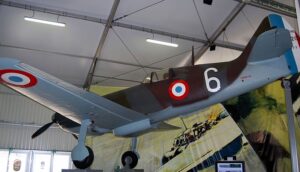Time Period: World War II
Country of Origin: Germany
Type: Reconnaissance and Surveillance
Manufacturer: Blohm & Voss
Blohm & Voss BV 138 Aircraft Overview
The Blohm & Voss BV 138 was a German flying boat used by the Luftwaffe during World War II primarily for maritime reconnaissance and anti-submarine warfare operations. Designed and manufactured by the Blohm & Voss company, the BV 138 was known by its nickname “Der Fliegende Holzschuh” or “The Flying Clog” due to its distinctive shape.
The BV 138 had a unique tri-motor configuration, with three engines mounted above the wing on struts. This design provided the aircraft with good stability and performance, especially during long-range patrols over the open ocean. The aircraft’s hull was constructed primarily of wood, which earned it the nickname “The Flying Clog.”
One of the most notable features of the BV 138 was its versatility and adaptability to a variety of mission roles. It was equipped with a comprehensive array of reconnaissance equipment, including cameras, radar, and radio communication systems, allowing it to gather intelligence on enemy shipping, naval movements, and coastal defenses.
In addition to reconnaissance duties, the BV 138 was also used for anti-submarine warfare, where it would patrol maritime convoy routes and conduct search and destroy missions against enemy submarines. It was armed with defensive machine guns and depth charges, enabling it to engage enemy submarines and protect friendly shipping.
The BV 138 saw extensive service in both the Atlantic and Mediterranean theaters of operation, where it played a crucial role in protecting German naval assets and disrupting Allied maritime supply lines. It also operated in the Baltic Sea and North Sea, where it conducted reconnaissance missions along the coastline and monitored Allied naval activity.
Blohm & Voss BV 138C-1 Specifications
- Crew: Six (pilot, navigator, radio operator, nose-gunner, rear-gunner, upper-rear gunner)
- Capacity: up to 10 passengers
- Length: 19.85 m (65 ft 1 in)
- Wingspan: 26.94 m (88 ft 5 in)
- Height: 5.9 m (19 ft 4 in)
- Wing area: 112 m2 (1,210 sq ft)
- Empty weight: 11,770 kg (25,948 lb)
- Gross weight: 14,500 kg (31,967 lb)
- Max takeoff weight: 17,650 kg (38,912 lb)
- Fuel capacity: 3,750 L (990 US gal; 820 imp gal) maximum internal fuel
- Powerplant: 3 × Junkers Jumo 205D Six-cylinder liquid-cooled opposed piston diesel engines, 647 kW (868 hp) each for take-off
- Propellers: 3-bladed constant-speed propellers
Blohm & Voss BV 138C-1 Performance
- Maximum speed: 285 km/h (177 mph, 154 kn) at sea level at 14,000 kg (31,000 lb) at sea level
- Cruise speed: 235 km/h (146 mph, 127 kn) at 1,000 m (3,300 ft)
- Range: 1,220 km (760 mi, 660 nmi) at 195 km/h (121 mph; 105 kn)
- Ferry range: 4,300 km (2,700 mi, 2,300 nmi) with max fuel
- Endurance: Five hours and 30 minutes (standard configuration); 18 hours (ferry configuration)
- Service ceiling: 5,000 m (16,000 ft) at 14,500 kg (32,000 lb). 2,800 m (9,200 ft) at 17,650 kg (38,910 lb)
- Rate of climb: 3.67 m/s (722 ft/min)
- Time to altitude: 3,170 m (10,400 ft) in 24 minutes
- Wing loading: 114.2 kg/m2 (23.4 lb/sq ft)
- Power/mass: 0.106 kW/kg (0.064 hp/lb)
Blohm & Voss BV 138C-1 Armament
- Guns:
-
- 2 × 20 mm (0.787 in) MG 151 cannon, one in a nose turret and one in the rear fuselage covering upper rear area
- 1 × 13 mm (0.512 in) MG 131 machine gun in open position behind the central engine, covering the top rear area
- 1–3 × 7.92 mm (0.312 in) MG 15 machine guns (optional)
- Bombs: :* up to 3 × 50 kg (110.2 lb) bombs or 2 × 150 kg (330.7 lb) depth charges under starboard wing root, and with the Umbau set, the same payload could be attached to the port wing as well.
Blohm & Voss BV 138 Image Gallery
More Luftwaffe Aircraft
The Luftwaffe, the German air force during World War II, fielded a diverse range of aircraft that played critical roles in the conflict. These aircraft encompassed fighters, bombers, reconnaissance planes, transport aircraft, and more. Explore others:

Messerschmitt Bf 110
The Messerschmitt Bf 110 was a German twin-engine destroyer fighter-bomber developed in Nazi Germany in the 1930s and used in WW2.

Dornier Do 17
The Dornier Do 17 was a German twin-engined light-bomber produced by Dornier for the German Luftwaffe during World War II.

Focke-Wulf Ta 152
The Focke-Wulf Ta 152 was a World War II German high-altitude fighter-interceptor that entered service with the Luftwaffe in January 1945.

Focke-Wulf Fw 189 Uhu
The Focke-Wulf Fw 189 Uhu is a German twin-engine, three-seat tactical reconnaissance and army cooperation aircraft used during WW2.

Fieseler Fi 156 “Storch”
The Fieseler Fi 156 “Storch” was a German reconnaissance & communications aircraft built by Fieseler before and during World War II.










